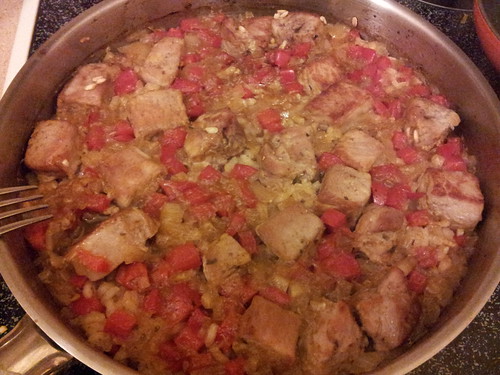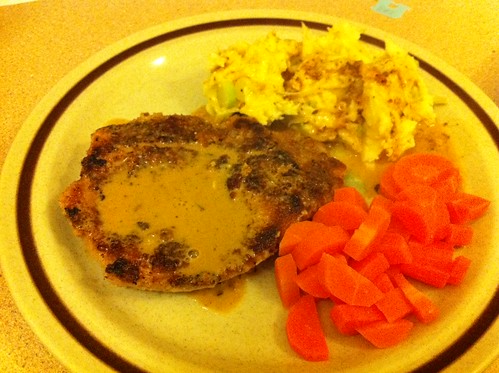Pork fillet is one of my favourite cuts of pork. That is despite the fact that it has no rind. It’s easy and quick to prepare and usually retains a degree of moisture that will disappear in other cuts with sloppy cooking (although see my recent pork chop post for a way of avoiding that problem!).
I’ve previously blogged a pork fillet recipe, where the meat is served with a white wine and cream sauce. This time I give you something which is very much a one pot meal – it’s both easy and easy on the washing up.
This Rose Prince recipe comes from the Telegraph where it’s called “peppered pork fillet”. That’s because in the UK what we in Australia call a “capsicum” is called a “pepper” – not because this is a spicy dish.
Begin by preheating your oven to 180°C (fan, 200°C convention).
In an oven safe frying pan, heat some light olive oil and fry up about 500g of pork fillet. The original recipe says to cut the fillet into small dice but I cut it into discs a cm or so thick. I think this way you run less risk of the meat overcooking and you get satisfying pieces of meat on your plate. I also note that in the photo that accompanies the original article the pork hardly looks like small dice!
When the fillet is browned nicely, add half a red capsicum, finely chopped, a clove of garlic (chopped) and a pinch or two each of paprika, ground coriander and allspice. Give this all a stir around, then add 5 tbsp of risotto rice (the recipe specifies Carnaroli, but I always use Arborio because that’s what I have in the cupboard). Then add stock to the pan – I use one of the little pots of stock jelly and top up with water. You need add enough water to cover the rice by a cm or so.
Bring this all to the boil, then turn down to a simmer and cook on the stove top for 8 minutes (and yes, I do actually time this!).
When the 8 minutes is up, cut a cartouche from baking paper (that means “cut a circle of baking paper to cover your pan”) and cover the pan with it (no lid required) before putting it in the oven.
Cook in the oven until the rice is done and the stock has been absorbed. The recipe says 10 minutes, but I never find that quite long enough (more like 25!) – but I do like to make sure plenty of the stock has been absorbed so that the finished product isn’t too soupy.
Serve straight away, with a squeeze of lemon and a drizzle of olive oil.
I love this dish – it uses so few ingredients, it tastes fantastic (which suggests to me that allspice is underused in my kitchen) and it takes very little time to put together. I have used other cuts of pork – such as pork loin steaks – and while they will do in a pinch they do end up a bit tougher and drier than fillet.
A perfect mid week supper.



